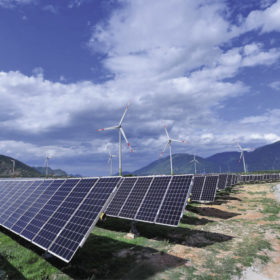
The Australian Energy Market Operator (AEMO) claims that the country already has the technical ability to safely operate a system in which three-quarters of the electricity comes from wind and solar. However, it needs to get the regulations right in order to do so.
Australia’s main electricity grid could safely derive up to 75% of its electricity from renewable energy sources by as soon as 2025, the Australian Energy Market Operator (AEMO) said in a new study this week. However, this will only be possible if market conditions and the regulatory environment are modified.
On Thursday, AEMO released its much-anticipated Renewable Integration Study (RIS), which is the first stage of a multi-year plan to ensure system security in a future National Electricity Market (NEM) characterized by a high share of renewable resources. The report take projections from AEMO’s 20-year grid transition blueprint, the Integrated System Plan, and confirms that the grid is already capable of handling a very high penetration of intermittent renewables.
“Australia has the technical capability to operate a power system where three-quarters of our energy at times comes from renewable energy resources,” said Audrey Zibelman, AEMO’s managing director and CEO. “However, to do so requires changes in our markets and regulatory requirements. Otherwise, AEMO will be required to limit the contribution of these wind and solar resources to 50% or 60% of electricity supply at any point in time, even though they are the lowest-cost way of providing electricity.”
The share of renewable energy in the NEM has stood at roughly 25% in recent months; for brief periods, it has occasionally exceeded 50%. In total, the NEM has 17 GW of wind and solar generation capacity, according to AEMO data, with several regions hosting the world’s highest levels of wind and solar, including one of the highest levels of residential PV capacity.

By 2025, AEMO’s Draft 2020 ISP forecasts in its ‘central’ scenario that this could increase to 27 GW of wind and solar, including both utility-scale and distributed-generation solar PV. But as the NEM continues its transformation, the latest study makes clear that “today’s operating approaches and market frameworks are becoming less effective,” Zibelman claimed.
“Given the pace and complexity of change in the NEM, the study highlights the need for flexible market and regulatory frameworks that can adapt swiftly and effectively as our understanding of the changing power system evolves,” she added. “This is going to be particularly important in the areas of technical standards and frameworks for sourcing essential system services.”
Key challenges
Although the new report builds on international approaches to operating power systems with high penetrations of wind and solar generation, it also recognizes Australia’s unique challenges, such as network congestion, and system curtailment. In addition, it points to participant spill, which happens when renewable generation removes itself from the market (self-curtails) due to market signals.

Based on the findings in the RIS, AEMO says the following actions should be prioritized and implemented before 2025:
- Continue the design and deployment of the Energy Security Board’s (ESB) Market 2025 reform program, with a particular focus on system security service markets. As part of the program, the ESB is assessing market mechanisms that increase certainty around system dispatch and essential system services (inertia, system strength, minimum synchronous units, operating reserves, and flexibility) as real-time approaches. The ESB will recommend a high-level design to the COAG Energy Council by end of this year, for implementation by 2025.
- New standards and settings to maximize the potential contribution of distributed solar PV. In collaboration with the industry, via Standards Australia, the AEMO aims to update the national standard for inverters (AS/NZS4777.2) to account for bulk system disturbance and autonomous grid support capability. This echoes the findings of the recently released DER Roadmap in Western Australia, which recommends the implementation of a distribution-network visibility program, to enhance the understanding of power flows and constraints.
- The construction of required transmission resources identified in the ISP.
“The findings of this report have far-reaching implications for the energy sector in Australia now and in the coming years,” Zibelman said. “AEMO looks forward to working closely with stakeholders to explore the findings and actions arising from this report and develop an integrated program of priority focus areas to support the energy transition.”
In a statement on Thursday, Energy and Emissions Reduction Minister Angus Taylor said the report highlights the challenges of integrating record amounts of renewable energy into the grid. Not surprisingly, Taylor’s interpretation of AEMO’s findings boil down to another call for more gas generation in the NEM.
“The AEMO study recognizes solar and wind generation alone aren’t enough. Minimum levels of inertia that are ordinarily provided by synchronous generation – such as a gas-fired power station – will be crucial to maintaining the security of any large power system,” Taylor said.
Last week, he suggested that the government is focused on investing in gas projects to provide more “cheap energy” to the market to support the recovery from the Covid-19 crisis.
Lắp đặt điện mặt trời Khải Minh Tech
https://ift.tt/2X7bF6x
0906633505
info.khaiminhtech@gmail.com
80/39 Trần Quang Diệu, Phường 14, Quận 3
Lắp đặt điện mặt trời Khải Minh Tech
https://ift.tt/2ZH4TRU
Không có nhận xét nào:
Đăng nhận xét